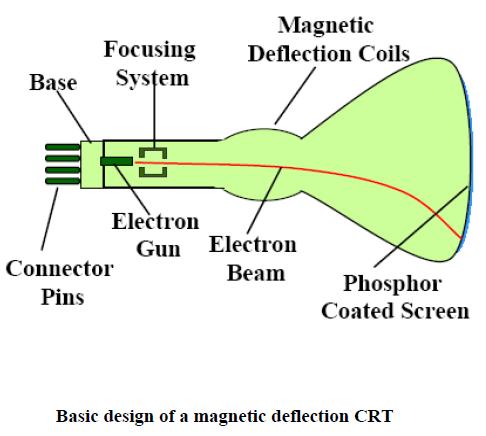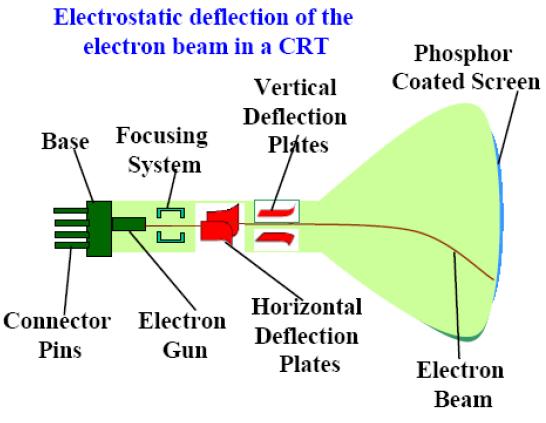The primary output device in a graphics system is a video monitor. The operation of most video monitors is based on the standard cathode ray tube (CRT) design.
A CRT is an evacuated glass tube. An electron gun at the rear of the tube produces a beam of electrons which is directed towards the front of the tube (screen). The inner side of the screen is coated with phosphor substance which gives off light when it is stroked by electrons. It is possible to control the point at which the electron beam strikes the screen, and therefore the position of the dot upon the screen, by deflecting the electron beam.
The beam is positioned on the screen by a deflection system of the cathode-ray-tube consists of two pairs of parallel plates, referred to as the vertical and horizontal deflection plates.The intensity of the beam is controlled by the intensity signal on the control grid.
The Cathode Ray Tube
 The voltage applied to vertical plates controls the vertical deflection of the electron beam and voltage applied to the horizontal deflection plates controls the horizontal deflection of the electron beam. There are two techniques used for producing images on the CRT screen: Vector scan / random scan and Raster scan.
The voltage applied to vertical plates controls the vertical deflection of the electron beam and voltage applied to the horizontal deflection plates controls the horizontal deflection of the electron beam. There are two techniques used for producing images on the CRT screen: Vector scan / random scan and Raster scan.
When the phosphor is hit by the electron beam it absorbs energy and jumps to a higher quantum-energy level. As it returns to its normal level it emits visible light i.e. it phosphoresces. In the phosphors used in graphics devices the persistence of the phosphorescence is typically 10-60 microseconds.
Before the human visual system can see a transient image it must be continually redrawn (refreshed) at a rate higher than the critical fusion frequency of the human visual system. To allow the human visual system to see a continuously refreshed image without flicker the refresh rate has to be at least 60 c/s.
 To allow continuous refreshing of an image there must be some stored representation of the image from which the refresh system can obtain the graphical information required to re-draw the image. This representation nowadays is invariably a set of values of Intensity / colour at each of a discrete set of points laid out in a rectangular array covering the screen.
To allow continuous refreshing of an image there must be some stored representation of the image from which the refresh system can obtain the graphical information required to re-draw the image. This representation nowadays is invariably a set of values of Intensity / colour at each of a discrete set of points laid out in a rectangular array covering the screen.
While it may seem a disadvantage to continually refresh the image there are some very important advantages of such refresh type systems. For example it is possible to edit an image by changing the stored representation between refresh cycles for what appears to be instantaneous updating of the image. Compare this with some earlier systems in which the only way to carry out an edit was to clear the whole screen and then redraw the whole image. Also by changing the stored representation between refresh cycles animation is possible.
 Dinesh Thakur holds an B.C.A, MCDBA, MCSD certifications. Dinesh authors the hugely popular
Dinesh Thakur holds an B.C.A, MCDBA, MCSD certifications. Dinesh authors the hugely popular